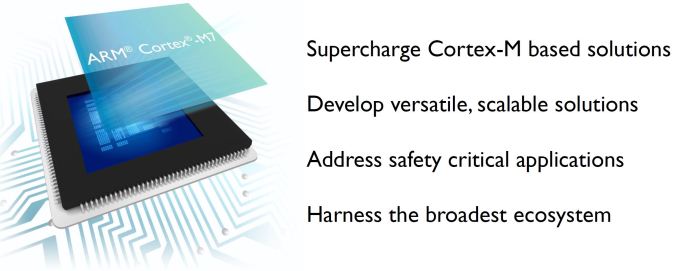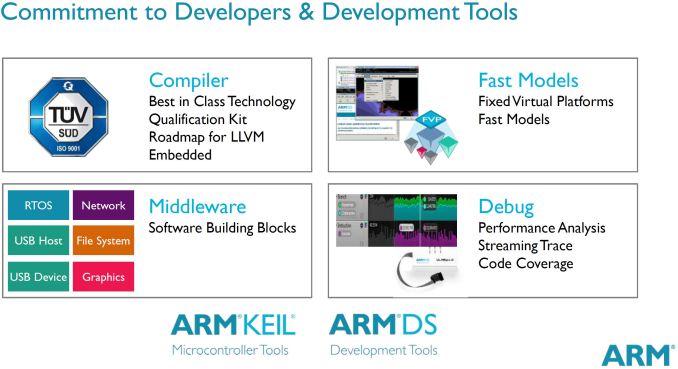Cortex-M7 Launches: Embedded, IoT and Wearables
by Stephen Barrett on September 23, 2014 7:01 PM ESTFinal Words
In the past two days we have seen two announcements targeting IoT and wearable devices from major semiconductor companies. These announcements may seem premature as there hasn’t been a game changing device release like the original iPhone was, but the companies involved are simply doing what they have done before and investing in the future. Much of ARMs work before the ARM11 processor was behind closed doors or simply unnoticed by consumers at large, but it was there. Watching the suppliers evolve to provide suitable products, documentation, and tooling for something new is exciting.
The Coretex-M7 processor pushes the performance of ARMs dedicated MCU line to new levels, helping ARM further consolidate MCUs and DSPs into a single ARM ISA compatible 32-bit CPU. The increased performance and features also allow device makers to rely more on the always on MCU and power up the AP much less often, improving overall power consumption and even enabling devices that were previously impractical.
ARM also invested in improving the interrupt latency of the M7 and provides qualification kits for safety critical standards like ISO 26262 (automotive) and IEC61508. Anyone with experience here knows just how expensive creating these kits can be.
For major MCU SoC vendors like ST, Atmel, NXP, Freescale, TI, and others, the prospect of integrating a CPU core off-the-shelf from ARM means less R&D investment in processor design and documentation with a potentially greater payoff by tapping into the ARM ecosystem. Additionally, rather than hand coding their own development IDEs and compilers, they can serve their users with existing open source alternatives. To consumers, consolidation could bring similarities to the Windows + Intel days when software developers gained immense efficiency.
Many IoT and wearable devices today accomplish their roles using high power A series application processors. This is by design, as the companies providing them simply reused their smartphone processors to get product to market as fast as possible. Designing a heterogeneous system using MCUs and application processors is more complex but the benefits are undeniable. As the IoT and wearable devices mature, we will keep a close eye on the underlying technology of future devices and hope to report some positive changes over the next year.












43 Comments
View All Comments
Stephen Barrett - Tuesday, September 23, 2014 - link
ARM specifically advised against comparing performance numbers across architectures, saying it was an apples and oranges comparison.Despite similar numbers in these very synthetic benchmarks, when running actual application code , the M7 will never compete with the A series. The numbers are only useful comparing within the family.
Wilco1 - Wednesday, September 24, 2014 - link
Sure an M7 will never run Android, but that's not the point. v7-M and v7-A share the same Thumb-2 ISA and use the same compiler backend, so it's not apples/oranges. You can run the same binary on an M7 and A7 if you wish.Due to its shorter pipeline, an M7 should beat an equivalently clocked A7. Of course an A7 can clock 2 times as high in 28nm so it wins in absolute performance. However that still means M7 is a huge leap from an M3/M4.
tuxRoller - Wednesday, September 24, 2014 - link
The chart says 2.14-3.23 dmips/mhz, or 5.04 coremark/mhz, so atom d525 or core i5-2400 for coremark, or between intel pentium/pentium pro and pentium 3.http://www.eembc.org/coremark/index.php
https://en.wikipedia.org/wiki/Instructions_per_sec...
Flunk - Thursday, September 25, 2014 - link
Intel Quark.KlausWalter - Wednesday, September 24, 2014 - link
For those guys who understand german here is the best review so far including the first implementation of the Cortex-M7 in a real MCU, a so called STM32F7 Family delivered by ST Microelectronics: http://www.elektroniknet.de/halbleiter/mikrocontro... Google translator may help....uningenieromas - Wednesday, September 24, 2014 - link
The three big guys in the MCU world (Atmel, Freescale and ST) are already working in Cortex M7 processors and I'm sure they already have a internal implementation of the MCUs:http://www.arm.com/about/newsroom/arm-supercharges...
Freescale has it already in it's roadmap, and it's called Kinetis X.
jdesbonnet - Wednesday, September 24, 2014 - link
Microchip is also a 'big guy' but is conspicuously absent from the ARM party. Which is a pity: I like their stuff, but I've now standardized on the ARM Cortex-M family of MCU.ah06 - Wednesday, September 24, 2014 - link
So we expect to see this as the core of an SoC in wearables and for high end wearables, ARM recommends a gimped A7. Well what about the R series that falls right in between?I'm still very fuzzy on the relative comparisons between the wearable processors. Maybe do an article comparing Aster platform (ARM7ESJ), Cortex-M4/M7, Cortex-Rx, Cortex-A7/A53
Thanks
FunBunny2 - Wednesday, September 24, 2014 - link
-- the M series processors are considered microcontrollers and not application processors, mainly because they lack a memory management unit (MMU).Well, then, the X86 wasn't a real cpu, because the MMU was off chip for rather a while. Not until the 386 was it really implemented.
hammer256 - Wednesday, September 24, 2014 - link
So what are the target market of the M series and R series? R series is higher performance? Both lack MMU right? The distinction between the two lines are kinda blurry to me.